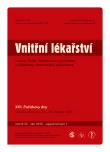The HELLP syndrome – its course and endothelial activation markers activity
Authors:
O. Šimetka 1; J. Procházková 2; J. Gumulec 3; I. Michalec 1; H. Zewdiová 1; R. Kolářová 5; M. Procházka 4
Authors‘ workplace:
Porodnicko-gynekologická klinika FN Ostrava, přednosta MUDr. Ondřej Šimetka
1; Hemato-onkologická klinika Lékařské fakulty UP a NF Olomouc, přednosta prof. MUDr. Karel Indrák, DrSc.
2; Ústav klinické hematologie FN Ostrava, přednosta MUDr. Jaromír Gumulec
3; Porodnicko-gynekologická klinika Lékařské fakulty UP a FN Olomouc, přednosta doc. MUDr. Radovan Pilka, PhD.
4; Oddělení neonatologie FN Ostrava, prim. MU Dr. Renáta Kolářová
5
Published in:
Vnitř Lék 2010; 56(Supplementum 1): 98-103
Category:
16th Parizek's Days, Ostrava-Poruba, March 25th –26th 2010
Overview
Aims of the study:
Analysis of the course of pregnancy and its outcomes in patients with confirmed HELLP syndrome and comparison with published literature. An analysis of endothelial activation markers in patients with HELLP syndrome and their comparison with values found in physiological pregnancies.
Study design:
Prospective cohort study.
Study aim and methods:
We followed up 34 pregnancies complicated with the HELLP syndrome in women who gave birth at the Perinatology Centre Ostrava between 2004 and 2009. We performed analyses of endothelial activation markers using ELISA, immunoturbidimetry, ELISA with fluorogenic detection and flow cytometry and their levels were compared with values in the third trimester of physiological pregnancies.
Results:
Between 2004 and 2009 (64 months) 34 women gave birth at the Perinatology and Gynaecology Centre of the Faculty Hospital Ostrava who were diagnosed with laboratory-confirmed HELLP syndrome. The mean age of the researched women was 28.5 years, the mean gestational age at the time of pregnancy cessation was 33 weeks and 4 days. Only 2 women delivered spontaneously, 32 gave birth by caesarean section (CS), 54% of newborns were hypotrophic, 3 of these pregnancies were with twins. Deviations from laboratory norms in coagulation factors were identified in 22 patients, although clinical signs of a coagulation disorder were manifested in 8 patients (23.5%) only. A total of 6 patients were administered blood transfusion (18 units) and 9 patients were administered plasma (a total of 20 units). The mean duration of stay at the Intensive Care Unit was 3.2 days. None of the women died. One foetus was stillborn, postnatal period of 12 newborns (33.3%) was complicated with a serious morbidity. All pregnancies were terminated within 24 hours from the diagnosis. Of the endothelial activation markers, statistically significant deviations in the activity and levels of vWf antigen and in EPCR, MMP-2 and MMP-9 levels were observed. On the other hand, thrombomoduline, t-PA, PAI-1 and TIMP-2 levels were not statistically significantly higher in patients who developed HELLP syndrome compared to women with physiological gravidity.
Conclusion:
Early diagnosis and active management significantly contribute to prevention of severe forms of the HELLP syndrome. The HELLP syndrome is accompanied by statistically significant elevation in plasma levels of endothelial activation markers.
Key words:
HELLP syndrome – complication – morbidity – prediction – endothel
Sources
1. Aslan H, Gul A, Cebeci A. Neonatal Outcome in Pregnancies after Preterm Delivery for HELLP Syndrome. Gynecol Obstet Invest 2004; 58 : 96–99.
2. Bick RL. Syndromes of disseminated intravascular coagulation in obstetrics, pregnancy and gynecology. Objective criteria for diagnosis and management. Hematol Oncol Clin North Am 2000; 14 : 999–1044.
3. Detti L, Mecacci F, Piccioli A et al. Postpartum heparin therapy for patients with the syndrome of hemolysis, elevated liver enzymes and low platelets (HELLP) is associated with significant hemorrhagic complications. J Perinatol 2005; 25 : 236–240.
4. Ellison J, Sattar N, Greer I. HELLP syndrome: mechanism and management. Hosp Med 1999; 60 : 243–249.
5. Ertan AK, Wagner S, Hendrik HJ et al. Clinical and biophysical aspects of HELLP syndrom. J Perinat Med 2002; 30 : 483–489.
6. Gul A, Cebeci A, Aslan H et al. Perinatal outcomes in severe preeclampsia-eclampsia with and without HELLP syndrome. Gynecol Obstet Invest 2005; 59 : 113–118.
7. Haram K, Svendsen E, Abildgaard U. The HELLP syndrome: clinical issues and management. A Review. BMC Pregnancy Childbirth 2009; 26 : 8.
8. Katz VL, Watson WJ, Thorp JM Jr et al. Treatment of persistent postpartum HELLP syndrome with plasmapheresis. Am J Perinatol 1992; 9 : 120–122.
9. Martin JN Jr, Files JC, Blake PG et al. Plasma exchange for preeclampsia. I. Postpartum use for persistently severe preeclampsia-eclampsia with HELLP syndrome. Am J Obstet Gynecol 1990; 162 : 128–137.
10. Osmanagaoglu MA, Erdogan I, Zengin U et al. Comparison between HELLP syndrome, chronic hypertension, and superimposed preeclampsia on chronic hypertension without HELLP syndrome. J Perinat Med 2004; 32 : 481–485.
11. Procházková J, Dhaifallah I, Měchurová A et al. Monitorování hladin markerů aktivace endotelu během fyziologické gravidity. Česká gynekologie 2010; 75 : 92–100.
12. Sibai BM. Diagnosis, controversies, and management of the syndrome of hemolysis, elevated liver enzymes, and low platelet count. Obstet Gynecol 2004; 103 : 981.
13.Sibai BM, Ramadan MK, Usta ISM. Maternal Morbidity and Mortality in 442 Pregnancies With Hemolysis, Elevated Liver Enzymes, and Low Platelets (HELLP Syndrome). Am J Obstet Gynecol 1993; 169 : 1000–1006.
14. Šimetka O, Brychtová P, Procházková J et al. Laboratorní změny aktivace endotelu u syndromu HELLP = Changes of endothelium activation in HELLP syndrome. Gynekolog 2008; 17 : 54–56.
15.Taylor FBJ, Toh CH, Hoots WK et al. Towards definition, clinical and laboratory criteria, and a scoring system for disseminated intravascular coagulation. Thromb Haemost 2001; 86 : 1327–1330.
Labels
Diabetology Endocrinology Internal medicineArticle was published in
Internal Medicine

2010 Issue Supplementum 1
Most read in this issue
- Thrombocytopenia and coagulopathy in hepatopathy: an introduction into the issue
- Monitoring of coagulation parameters and options to influence them in patients with liver cirrhosis prior to invasive procedures
- Differential diagnosis of thrombocytopaenia in pregnancy
- The application of IPF (Immature platelet fraction) in laboratory diagnostics
